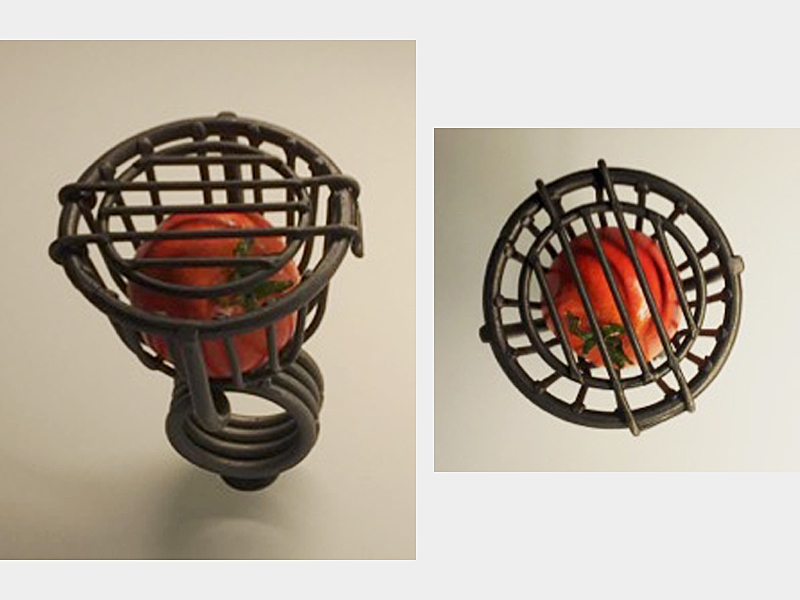Contemporary jewelry makers sometimes use experimental, nontraditional materials for their jewelry. The use of these kinds of materials often contributes to or sometimes even determines the meaning of the jewelry. The problem with these kinds of materials is that they are often not sustainable and hard to preserve. That is why these materials cause specific conservation problems that are comparable with the conservation problems encountered in the contemporary visual arts.
Nontraditional art forms, such as multimedia installations or performances, are naturally variable due to the concept, technology, or materials used (Van Wegen 1999; Laurenson 2006; Irvin 2008; Van de Vall et al. 2011; Van Saaze 2013; Van de Vall 2015). Some of the materials in a work of art can change over time because, for example, materials perish or equipment no longer functions. A material that is characteristic for the artwork may disintegrate in such a way that it can no longer be restored. This material has to be replaced in order to keep the artwork together or functioning, but with the result being that the identity and the meaning of the work can change. The decision to replace material components of an artwork contradict with the traditional task of the conservator, which is namely to retain as much of the authentic material as possible. However, preserving the “original” material is not possible with artworks consisting of nondurable and unstable materials. The temporary or variable nature of these nontraditional artworks can ensure that these works of art cannot be kept in a fixed condition.

A piece of contemporary jewelry also meets the characteristics of a nontraditional artwork when it comes to conservation, and its conservation problems can thus be compared with those of the contemporary visual arts. Contemporary jewelry can contain materials that are hard to preserve, such as organic material. This material makes the piece of jewelry inherently changeable, with the risk being that at a certain moment in time some of the original material has to be replaced. The meaning of the jewelry can change when conservators decide to replace the decayed material with a different kind of material than originally was used. The fact that contemporary jewelry is the product of the artistic vision of its maker, and thus contains an artistic concept and identity, needs to be kept in mind with the conservation of the jewelry. The choice for a certain type of material is mostly part of the artistic concept and identity of the piece.
An example of such a conservation treatment where the conservators replaced “original” material with an alternative one is Cherry Ring (1994), by Hans Stofer, from the collection of the Neue Sammlung in Munich. The conservation department, together with the curators, decided to place an artificial tomato in the ring instead of placing a real tomato, as the original concept required. The question is, does (a part of) the meaning of the ring get lost now that there is an artificial tomato placed inside the ring? Because there are no written ethics for the conservation of contemporary jewelry, I will use two models of thought employed for the conservation of contemporary art to analyze the decision-making process of the Neue Sammlung. These models are the decision-making model of the Foundation for the Conservation of Modern Art (1999) and the distinction between different forms of authenticity (Ex 1993; Muñoz-Viñas 2004; Laurenson 2006).
A single, unprocessed, cherry tomato is a nondurable material that will decay within a short period of time. It is time-consuming and expensive to open the showcase in which Cherry Ring is exhibited on a weekly basis (Tim Bechthold, personal information). It takes at least four people to open it. That is why the conservators and curators of the Neue Sammlung decided to replace the cherry tomato in Stofer’s ring with an artificial one as long as it is on display. They tried to make an artificial tomato that looks as realistic as possible. With this “illusionistic” approach, the conservators and curators hoped to make the original concept of the ring as clear as possible for the public, without the trouble of opening up the showcase every week to place a new tomato. The conservators and curators are aware of the fact that this artificial tomato doesn’t belong to the object (Hoelscher, personal information).

With their decision-making model for the conservation of modern and contemporary art, the Foundation for the Conservation of Modern Art determined that the more unusual the material is, the more it contributes to the meaning of the work.[1] As mentioned before, alterations to, or replacement of, this material may cause a change in the meaning of the work, because the original concept of an artwork is based on this material. This is also the case with Cherry Ring. The title of the piece refers to the object (and therefore also the material) that Stofer has chosen to place inside the ring. The Cherry Ring is a cherry ring because of the cherry tomato. Can we conclude that (a part of) the meaning of the piece is now lost, because there is no real cherry tomato inside the ring which is on display in the Neue Sammlung? The visitor will probably not see the difference between an artificial tomato and a real tomato, but the concept of the artist is not imitated. Therefore, one can speak of a loss of meaning.
The loss of material can not only cause a loss in meaning, but can also affect the authenticity of the piece. Keeping the Cherry Ring in a material authentic state is not an option, because a real tomato perishes very quickly. So if this is no longer an option, then what are conservators preserving in order to keep this artwork an authentic artwork? Dutch art historian Nicole Ex distinguished different forms of authenticity besides the material authenticity. These are conceptual authenticity, functional and contextual authenticity, ahistorical and historical authenticity.[2] By preserving an object in its conceptual authentic state, the original concept of the artist is being kept in mind in the conservation process, even if that means that the original materials will no longer be preserved. This is what happened with Stofer’s ring, although its current state can’t be called a conceptual authentic state. The authentic concept requires the use of a real cherry tomato, not an artificial one. The care with which the Neue Sammlung conservators made the artificial tomato look as real as possible, and the fact that the conservators make clear that they do not consider the artificial tomato a part of the artwork, show that the conservation treatment did not cause a loss of the original concept. It is fairly easy to replace the artificial tomato with a real one.
A conservator has to make different considerations and decisions when it comes to the conservation of some pieces of contemporary jewelry. When the conservator pursues the original intention of the artist, it is possible that an artwork perishes because this is part of the concept. However, this goes against our desire for preservation. With preserving meaning and authenticity in mind, the conservator is thus forced into contradictory acts: Having a preference for a certain form of authenticity can lead to the elimination of one or more other authentic aspects (Ex 1992). Replacing material aspects of a piece can preserve the representation of a piece, but it can mean that the authentic concept of the piece gets lost. Sometimes it is not possible to replace certain material aspects of a piece, and one has to accept that the piece has lost its meaning forever. Every piece of jewelry has its own conservation problems in terms of material or artistic concept. It is therefore important that every work of art be viewed as an individual case, to ensure that the meaning of the piece can be maintained as well as possible.
References
Ex, Nicole. Zo Goed als Oud: de Achterkant van Restaureren. Amsterdam: Amber, 1992.
Foundation for the Conservation of Modern Art. “The Decision-Making Model.” In Modern Art: Who Cares? Amsterdam: The Foundation for the Conservation of Modern Art and Het Nederlands Instituut voor Cultureel Erfgoed, 1999.
Irvin, S. “The Ontological Diversity of Artworks.” In New Waves in Aesthetics. London: Palgrave Macmillan, 2008.
Laurenson, Pip. “Authenticity, Change and Loss in the Conservation of Time-Based Media Installations.” In Tate Papers, 2006. http://www.tate.org.uk/download/file/fid/7401.
Muñoz-Viñas, Salvador. Contemporary Theory of Conservation. Amsterdam: Elsevier Ltd, 2004.
Van de Vall et al. “Reflections on a Biographical Approach to Contemporary Art Conservation.” In ICOM-CC: 16th Triennial Conference. Lisbon, September 19–23, 2011.
Van de Vall, Renée. “The Devil and the Details: The Ontology of Contemporary Art in Conservation Theory and Practice.” British Journal of Aesthetics 55 (2015), no. 3.
Van Saaze, Vivian. Installation Art and the Museum. Amsterdam University Press, 2013.
Van Wegen, Rik. “Between Fetish and Score: The Position of the Curator of Contemporary Art.” In Modern Art: Who Cares? Amsterdam: The Foundation for the Conservation of Modern Art and Het Nederlands Instituut voor Cultureel Erfgoed, 1999.
Interviews conducted
Petra Hoelscher, senior curator at the Neue Sammlung in Munich. Interview conducted in March 2017.
Tim Bechthold, senior conservator at the Neue Sammlung in Munich. Interview conducted in June 2017.




